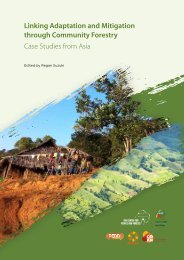Desktop Study on - Regional Climate Change Adaptation ...
Desktop Study on - Regional Climate Change Adaptation ...
Desktop Study on - Regional Climate Change Adaptation ...
Create successful ePaper yourself
Turn your PDF publications into a flip-book with our unique Google optimized e-Paper software.
Assessment of Capacity Gaps and Needs of South East Asia Countries<br />
in Addressing Impacts, Vulnerability and Adaptati<strong>on</strong> to <strong>Climate</strong> Variability and <strong>Climate</strong> <strong>Change</strong><br />
Internati<strong>on</strong>al Water Management Institute (IWMI)<br />
are currently investigating impacts of climate change<br />
<strong>on</strong> crop yield at a finer spatial scale (Roth, 2009).<br />
The preliminary result shows that crop yields are<br />
predicted to increase than decrease in most of the<br />
areas. Furthermore, it would provide benefits to<br />
drier agricultural lands if precipitati<strong>on</strong> during the<br />
wet seas<strong>on</strong> increases, especially al<strong>on</strong>g with reducti<strong>on</strong><br />
in frequency and durati<strong>on</strong> of droughts within the<br />
seas<strong>on</strong> (Roth, 2009).<br />
Vulnerability and Adaptati<strong>on</strong> in the<br />
Agriculture and Food Security Sector<br />
As much as climate change impacts can potentially<br />
offer opportunities, it also adds threats to the<br />
country’s agricultural sector and food security,<br />
depending <strong>on</strong> characteristics of impacts,<br />
geographical areas and seas<strong>on</strong>s. Paddy cultivati<strong>on</strong><br />
is mainly determined by flood and rainfall patterns.<br />
Increase in flooding in wetter areas may generate<br />
a risk of preventing rice cropping in low-lying<br />
areas if they are frequently flooded. In other<br />
words, the shortcoming of expanded irrigati<strong>on</strong> and<br />
water harvesting schemes in Cambodia makes the<br />
agricultural sector vulnerable to the climate change<br />
effects. The followings are examples of current<br />
adaptati<strong>on</strong> strategies practiced at the nati<strong>on</strong>al and<br />
local levels as a resp<strong>on</strong>se to their vulnerability,<br />
which can be categorised into four adaptati<strong>on</strong><br />
schemes: decentralisati<strong>on</strong> of irrigati<strong>on</strong> management<br />
to communities, adapti<strong>on</strong> of agricultural practices<br />
to changing climatic c<strong>on</strong>diti<strong>on</strong>, planning for disaster<br />
reducti<strong>on</strong>, promoti<strong>on</strong> of informati<strong>on</strong> exchanges.<br />
Decentralizati<strong>on</strong> of irrigati<strong>on</strong> management to<br />
communities<br />
The RGC and IWMI have implemented a project to<br />
transfer operati<strong>on</strong> and maintenance of small scale<br />
irrigati<strong>on</strong> systems to communities through the<br />
creati<strong>on</strong> of water user committees (IWMI, 2008). This<br />
project aims at increasing agricultural productivity<br />
and improving farmers’ incomes through enabling<br />
farmers to take over the management of their<br />
irrigati<strong>on</strong> systems. The IWMI has assisted in capacity<br />
building of the government to adopt and implement<br />
the participatory irrigati<strong>on</strong> management and<br />
development in 11 pilot irrigati<strong>on</strong> systems whereby<br />
water user committees has been formed and served<br />
various levels of functi<strong>on</strong>ality.<br />
Adapti<strong>on</strong> of agricultural practices to changing<br />
climatic c<strong>on</strong>diti<strong>on</strong><br />
The Cambodian Center for <str<strong>on</strong>g>Study</str<strong>on</strong>g> and Development<br />
in Agriculture (CEDAC) has experimented<br />
methodologies <strong>on</strong> growing vegetables all year<br />
around that reflect changing envir<strong>on</strong>ments of wind,<br />
rain and water logging. CEDAC has also introduced<br />
the System of Rice Intensificati<strong>on</strong> (SRI), which is<br />
a method of rice farming that focuses <strong>on</strong> organic<br />
farming practices, such as use of composting under<br />
tilling rice husk and seed selecti<strong>on</strong> (Solar, 2009).<br />
Similar to the c<strong>on</strong>cept of small-scale organic farming,<br />
is another initiative of the SRI that features the<br />
transplant young seedlings singly and widely spaced.<br />
Internati<strong>on</strong>al Federati<strong>on</strong> of Agricultural Producers<br />
(IFAP) has encouraged farmers to apply SRI that<br />
is managed in the processes of a) drainage of rice<br />
paddies, b) watering the seedlings by hand if there is<br />
no rain to keep the soil moist, c) minimum irrigati<strong>on</strong>;<br />
and d) early weeding (IFAP, 2009). It is reported<br />
that <strong>on</strong>e of the main drivers for farmers to adopt the<br />
SRI is that the yield is higher than the <strong>on</strong>e from the<br />
traditi<strong>on</strong>al practice and that the SRI requires less<br />
seeds. The Development Partnership in Acti<strong>on</strong> (DPA)<br />
has assisted communities in adaptati<strong>on</strong> of rice with a<br />
more resilient trait (Van Aalst, M. K., T. Cann<strong>on</strong>, and I.<br />
Burt<strong>on</strong>, 2008 cited in Solar, 2009).<br />
At the household and individual level, the following<br />
adaptati<strong>on</strong> measures have been observed: building<br />
of elevated enclosure for livestock, increasing<br />
household food stock as well as feedstock for<br />
animals, shifting crop planting dates and switching<br />
to flood-resistant crop varieties (Royal Government<br />
of Cambodia, 2005 cited in Resurrecci<strong>on</strong> et al., 2008).<br />
Planning for disaster reducti<strong>on</strong><br />
The DPA has encouraged communities to develop a<br />
plan to reduce vulnerability to sadden disasters such<br />
as crop loss (Van Aalst, M. K., T. Cann<strong>on</strong>, and I. Burt<strong>on</strong>,<br />
2008 cited in Solar, 2009). This risk management<br />
oriented adaptati<strong>on</strong> seems to have been already<br />
practiced at the local scale. The study c<strong>on</strong>ducted by<br />
Resurrecci<strong>on</strong> et al. (2008) indicates that the rainfed<br />
rice farmers in Kandal province resp<strong>on</strong>d to<br />
increasingly unpredictable rainfall through dividing<br />
their rice plots into two- <strong>on</strong>e half for employing<br />
c<strong>on</strong>venti<strong>on</strong>al wet-paddy rice techniques that are<br />
resistant to heavy precipitati<strong>on</strong> and the other half<br />
for adopting a system of rice intensificati<strong>on</strong>, which is<br />
a cultivati<strong>on</strong> technique resistant to drought.<br />
Promoti<strong>on</strong> of informati<strong>on</strong> exchanges<br />
The CEDAC has facilitated farmers to participate in<br />
climate change adaptati<strong>on</strong> networks and nati<strong>on</strong>allevel<br />
forums so that farmers gain informati<strong>on</strong><br />
generated at the nati<strong>on</strong>al and global levels. The<br />
Nati<strong>on</strong>al Fund for Farmer Research and Farmer to<br />
Farmer Extensi<strong>on</strong> is <strong>on</strong>e example of informati<strong>on</strong><br />
exchange venue to involve the farmer in local<br />
113

















